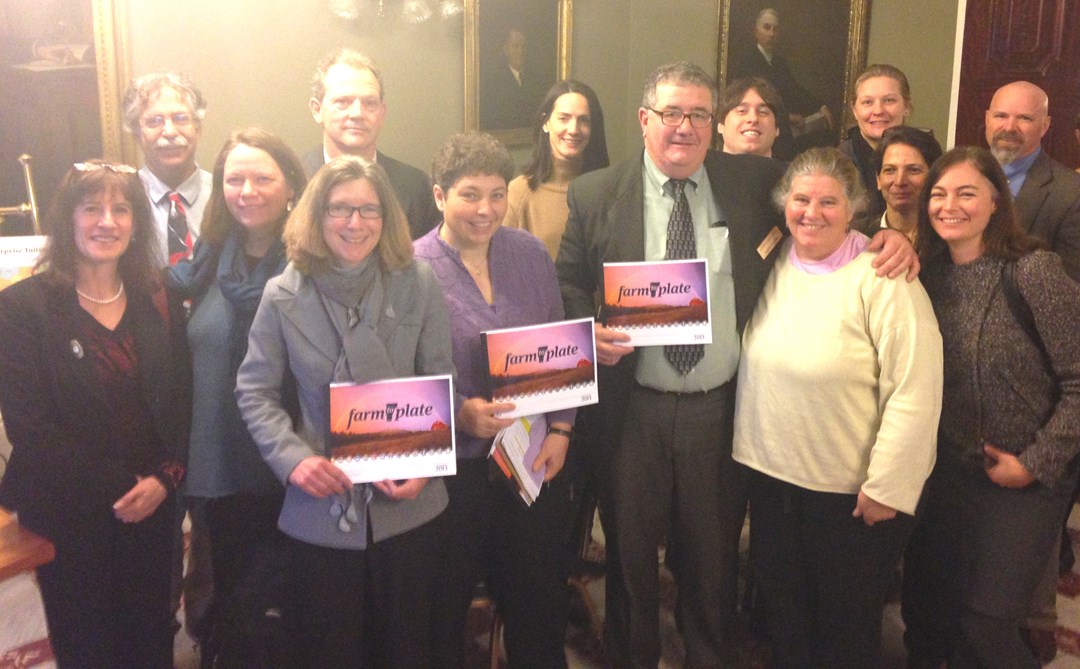Vermont’s food and farm sector adds 2,200 new food system jobs
January 15, 2014

Food entrepreneurs have added at least 2,220* new jobs and at least 199 new businesses to the Vermont economy since the 2009 launch of the Farm to Plate Investment Program. Over the same time period, total employment across all economic sectors grew by 7,654 new jobs. Food manufacturing jobs are at the heart of Vermont’s “Recession” recovery, increasing from 4,628 to 6,121 jobs (a 32% increase). These numbers were released yesterday by the Vermont Sustainable Jobs Fund in the 2013 Farm to Plate Annual Report.
“There are over 59,000 private sector jobs in our food system, and we expect this number to be even higher when the 2012 Census of Agriculture figures are released in March,” says Ellen Kahler, executive director at the Vermont Sustainable Jobs Fund, Farm to Plate’s backbone organization. “We are pleased with how the Shumlin Administration is investing in the further development of our food system, by supporting the Working Lands Enterprise Fund and Farm to Plate, because it represents a strong and growing sector of our economy.”
The Vermont Sustainable Jobs Fund actively tracks the progress of the 25 goals connected to the Farm to Plate Strategic Plan, which are reported annually to the legislature. The 2013 Annual Report can be accessed on the Vermont Food System Atlas—the Farm to Plate Strategic Plan, Network, and food and farm inventory website.
Companies like Green Mountain Coffee Roasters, Commonwealth Dairy, Black River Produce, and Vermont Smoke & Cure have all made large investments in order to expand their operations and have experienced significant sales increases, which has led to adding full-time employees.
Sodexo, a food service company that provides more than 30,000 campus and school meals per day in Vermont, sources approximately 15% of its food locally.
In 2013, more than $70 million in public, quasi-public and philanthropic loans and grants were made available to Vermont farm and food businesses, in addition to the private lending and owner equity that has gone into fueling these expansions.
In January 2011, when the Farm to Plate Strategic Plan was released, an economic analysis (using REMI, the same revenue forecast calculator used by the State of Vermont) indicated that with every 5% increase in food production in the state, 1,700 new jobs would be created. Goal #1 of the Farm to Plate plan is to increase Vermonters’ local food consumption from 5 to 10% over ten years. In only four and a half years, Vermont has surpassed what had been predicted to occur over a ten year period by 500 jobs.
“Yesterday, Farm to Plate Network leaders met with Governor Shumlin and testified with the Senate and House Committees on Agriculture, Forest Products, and Economic Development to share how our collective work over the past year has strengthened Vermont’s food system, created jobs, and increased local food access,” states Erica Campbell, Farm to Plate’s program director. Campbell coordinates the 300+ organizations and businesses within the Farm to Plate Network responsible for implementing the Strategic Plan. “The Network was formed just over two years ago and its impacts are already tangible—by working together collaboratively, we will reach the 25 goals of Farm to Plate faster than we could by working alone.”
Chuck Ross, Secretary, Vermont Agency of Agriculture, Food and Market comments, “Vermont’s Farm to Plate Network has emerged as a national model in its effectiveness in initiating and supporting changes in our local and regional food systems. As a result of our Farm to Plate conversation we are seeing the growth and evolution of a community-based food system that is growing healthy food, new jobs, and sustainable communities. The Vermont Sustainable Jobs Fund and all the various Vermont and regional partners are to be congratulated for this nationally leading collaboration.”
Secretary Ross serves on the Farm to Plate Steering Committee and most working groups within the Network have Agency of Agriculture staff involvement, many of whom provide critical leadership on task forces. Ten additional state agencies and departments are also actively engaged in Farm to Plate Network projects related to education, economic development, land use, energy, health, food security, and agritourism.
* Net new jobs and net new establishments are for the time period 2009 – 2nd Q 2013 (4 ½ years). Numbers are provided by the Vermont Department of Labor (QCEW) and the 2007 USDA Agriculture Census. 1,025 of these food system jobs have been added since the Shumlin Administration took office in 2011.
###
A core program of the Vermont Sustainable Jobs Fund (VSJF), Vermont Farm to Plate is the statewide initiative legislatively directed to strengthen Vermont’s food system and double local food production and consumption by 2020. The Farm to Plate Strategic Plan is Vermont’s ten year plan to increase economic development and jobs in Vermont’s food and farm sector and improve access to healthy local food for all Vermonters. Responsible for collectively implementing the strategies of the Plan, the Farm to Plate Network encompasses farms, food production businesses, specialty food producers, educational institutions, nonprofit organizations, capital providers and government. The Food System Atlas is the searchable Vermont farm and food inventory website designed to strengthen Vermont’s working landscape, includes all sections of the Farm to Plate Strategic Plan, and acts as the communication hub for the Farm to Plate Network.




